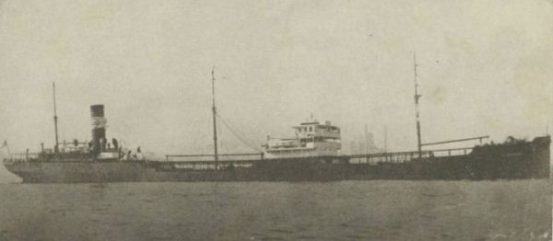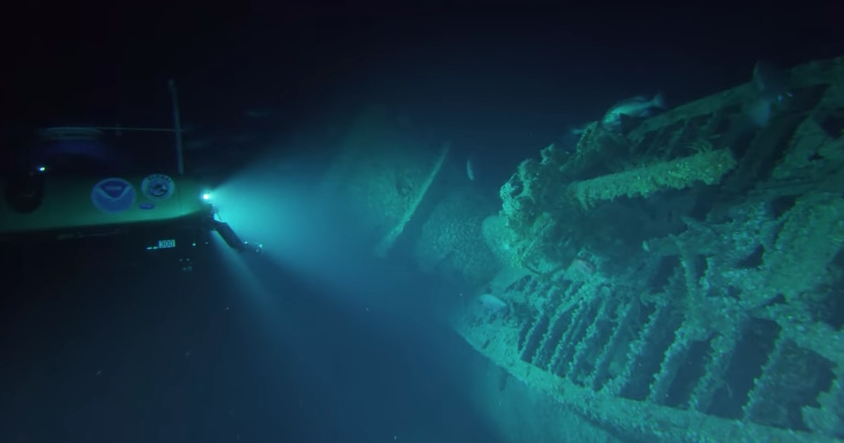For six months, one of the most horrific battles of WWII raged along the sandy shoreline of the Outer Banks. Beginning in January of 1942 until July of that year, German U-boats sank over 70 ships off the coast of North Carolina.
Joe Hoyt, Marine Archeologist for the National Monitor Marine Sanctuary, was at the Coastal Studies Institute for the February Science on the Sound talk. His presentation, “War Offshore! Honoring and Protecting a WWII Battlefield off the Carolina Coast,” offered a fascinating window into the terrible price of warfare and the ongoing efforts to identify the ships resting on the seafloor.
WWII is widely thought of as a foreign conflict, a war that occurred someplace else, on the battlefields of Europe or the Pacific. Yet one of the most violent battles was within sight of the Outer Banks, a battle pitting German U-Boats against Allied shipping routes.
The cost was high. Four U-boats never returned to Germany from their patrols. The allies suffered 1657 casualties, over 1200 of them Merchant Mariners.
As Hoyt explained, the seeds of the Battle of the Atlantic were sown at the end of WWI; Germany quickly came to the conclusion that they would not be able to compete with British surface ships, but Great Britain was an island nation, vulnerable to attacks on its supply chain.
“In rough terms, the Battle of the Atlantic was a war on commerce,” Hoyt said. “What they (the Germans) can do is cut off the flow of supplies to the UK.”
The Battle of the Atlantic was raging before the United States entered the war, but after the Japanese attacked Pearl Harbor, Germany declared war on the US four days later.
“A week after they declared war, the first U-Boat set sail for the coast of the United States,” Hoyt said. “By January 18 of 1942 the first ship is sunk off the coast of North Carolina.” The ship was the Allan Jackson, an oil tanker filled with oil sailing from Columbia to New York.

“This began a six month period where an enormous number of wrecks were sunk along the coast. The Outer Banks were in the forefront of that. These folks (the residents) were seeing this first hand,” Hoyt said.
By July of 1942 the scourge of U-boat attacks off the coast was largely ended. But why did it takes so long and cost so many lives?
As Hoyt notes, there were a number of factors working together slowing the response. The lend lease program that President Roosevelt had instituted giving the British Navy American ships for North Atlantic convoy duty meant fewer destroyers were available to protect the US coast. After the December 7 attack on Pearl Harbor, the biggest strategic concern was the Japanese navy, so there were not as many assets available for the East Coast.
There were also unsuccessful methods tried, the most notable an attempt to mine an area around Diamond Shoals that would give ships a safe haven. Two Allied ships were sunk…no U-boats.
It also took a while for a convoy system to be put into place.
But over time the Navy, working with the Coast Guard, did get it right. Convoys were escorted by destroyers and Coast Guard Cutters; “When in Doubt, Lights Out” became a mantra that people understood was important. And air patrols—perhaps the most deadly threat to the U-boats—were organized.
One of the most important and fascinating points of the presentation was the role the Merchant Marines played in battle. Hoyt pointed out that compared to any of the military services, the Merchant Marines suffered the highest percentage of casualties.
“You were more likely to lose your life as a member of the the Merchant Marines than you were if your were a Marine, in the Navy or any other member of the military service,” he said.
In spite of their service, it was not until the 1980s that they were given even partial official recognition for the role they played.
Hoyt’s discussion did not focus solely on history.
“What we have begun doing over the past 10 years…we’ve begun this comprehensive inventory of these WWII wrecks,” he said. “How can we communicate the idea of a battlefield most effectively.”
The comprehensive inventory is more than a simple count of wrecks. What it includes are the most recent advances in sonar technology and digital imaging. He and his team have also mapped where known wrecks currently rest, looking for the hotspots of the battle.
What is emerging is some remarkable information. This truly was a battlefield, with remains of ships scattered along the coastline, clearly concentrated is certain areas.
Divers and researchers are also finding shipwrecks that were thought lost in time. That was the case with the recently discovered U576 that was sunk in July of 1942.
By plotting where after battle reports indicated the engagement occurred, the approximate location of the sub was determined. Hoyt added that battle reports are notorious for being imprecise in pinpointing where conflict takes place.
Nonetheless, it it gave programmers at ECU numbers to input and a probability map was created. SS Bluefields, the ship the U576 sank just before she too was sent to the bottom, was found first—almost exactly where the map said it would be. And unclear at first, but apparent under closer examination, 240 meters away, the sub rested on the seabed.

The digital imaging that has come out of the U576 is the future of marine archaeology in many ways, allowing scientists to study in detail wrecks far beneath the surface.
The Coastal Studies Institute Science on the Sound series is a regular feature of Outer Banks life, occurring the third Thursday of every month except July and August. The subjects cover everything from shark nurseries, to the slave trade, to WWII.
